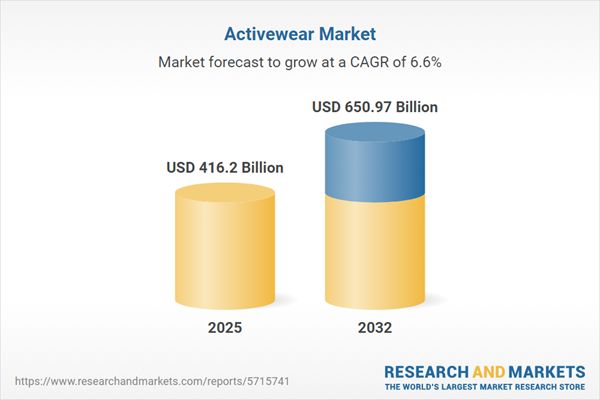Speak directly to the analyst to clarify any post sales queries you may have.
The activewear market is adapting to rapid changes as digital technologies, sustainability, and shifting consumer preferences reshape competitive priorities and strategic choices for industry leaders. Senior executives are seeking precise, actionable intelligence to guide decisions and maintain momentum in this evolving landscape.
Market Snapshot: Activewear Market Growth Analysis
The global activewear market is demonstrating strong growth fundamentals, with revenue forecasted to rise from USD 390.37 billion in 2024 to USD 416.20 billion in 2025. Sustained demand is set to fuel further expansion, targeting USD 650.97 billion by 2032, aligned with a 6.60% compound annual growth rate (CAGR). This positive outlook is reinforced by steadfast investments in innovative product development, advanced apparel technologies, and heightened activity across digital platforms. Current dynamics reflect increased attention to sustainability and a shift toward responsive sourcing strategies, as businesses address a more complex regulatory climate and evolving consumer needs. Trends such as strategic e-commerce investment, agile production models, and the rise of tailored product collections are collectively redefining market competitiveness.
Scope & Segmentation: Strategic Insights for the Activewear Market
This report presents a segmentation structure designed to enable senior leaders to optimize portfolios and allocate resources based on the most relevant category, consumer, and regional opportunities. Each segment is aligned to support agile strategies and effective risk management:
- Product Types: Technical outerwear, sports bras, performance socks, functional headwear, and activity-tuned tops expand innovation and address varied performance needs.
- Distribution Channels: Department stores, specialty retail, owned ecommerce, digital-native platforms, third-party marketplaces, and multi-brand outlets enable flexible reach and align with shifting purchase behaviors.
- Gender Segmentation: Men’s, women’s, and unisex collections support tailored design and marketing that optimize engagement with major consumer groups.
- Age Groups: Adult lines focus on adaptability and style, teen-focused offerings leverage trends and digital engagement, and children’s ranges emphasize durability and play-driven designs.
- Pricing Tiers: Luxury, premium, and mass-market options clarify brand positioning and help companies penetrate both value-driven and aspirational segments.
- Materials: Recycled fibers, certified synthetics, and natural fabrics foster responsible sourcing and reinforce compliance with sustainability benchmarks.
- Geographies: The Americas, Europe, Asia-Pacific, and Middle East & Africa each bring unique regulatory, cultural, and consumer considerations, impacting market entry, product localization, and growth strategies.
Leading players such as Nike, adidas, Anta Sports, PUMA, Lululemon Athletica, Under Armour, ASICS, VF Corporation, Columbia Sportswear, and Fila Holdings remain at the forefront of material advances and digital transformation, driving industry standards across each key segment.
Key Takeaways: Strategic Implications for Senior Leaders
- Building sustainability into sourcing and supply chains enhances transparency, strengthens compliance, and deepens stakeholder trust in brand values.
- Leveraging digital innovations—including virtual try-ons and personalized shopping journeys—enables brands to deliver improved engagement and adapt rapidly to evolving buyer behaviors.
- Pursuing alliances and strategic partnerships broadens distribution access and eases expansion into high-potential regions, fostering resilience against regional market pressures.
- Enhancing supply chain flexibility prepares organizations to address variability in demand, supporting responsive inventory management and safeguarding operational continuity.
- Establishing omnichannel retail strategies ensures consistency across online, brick-and-mortar, and third-party environments, supporting retention and meeting local buying expectations.
- Proactively monitoring compliance updates enables brands to anticipate regulatory change and sustain uninterrupted operations across multi-region footprints.
Tariff Impact: Strategic Implications for Supply Chains and Pricing
Recent U.S. tariffs targeting synthetic fibers and activewear necessitate a re-evaluation of sourcing and pricing approaches. Organizations are realigning operations closer to key markets, forging new regional supplier relationships to navigate emerging compliance and logistical challenges. Adopting flexible pricing and tailored marketing addresses cost fluctuations, protecting margins while ensuring continued market responsiveness. Evolving supply chain configurations support ongoing adaptability, helping businesses manage tariff risks and minimize performance disruption.
Methodology & Data Sources
This market analysis integrates insights from senior executive interviews, direct consumer survey responses, and reviewed secondary data. All findings are validated by industry specialists and cross-checked against current regulations to ensure their relevance and reliability for executive planning.
Why This Report Matters: Executive Value Proposition
- Supplies competitive benchmarks and strategic frameworks to support informed risk assessment and data-backed decision-making for senior leaders.
- Delivers actionable market segmentation and geographic insights, guiding targeted investments and optimal resource deployment in a fast-moving sector.
- Helps leadership connect sustainability and digital transformation priorities with meaningful growth levers aligned to company objectives.
Conclusion
This report enables executives to recalibrate strategy and resources with confidence, forming a reliable basis for decision-making in a transforming activewear industry.
Additional Product Information:
- Purchase of this report includes 1 year online access with quarterly updates.
- This report can be updated on request. Please contact our Customer Experience team using the Ask a Question widget on our website.
Table of Contents
3. Executive Summary
4. Market Overview
7. Cumulative Impact of Artificial Intelligence 2025
Companies Mentioned
The companies profiled in this Activewear market report include:- Nike, Inc.
- adidas AG
- Anta Sports Products Limited
- PUMA SE
- Lululemon Athletica Inc.
- Under Armour, Inc.
- ASICS Corporation
- VF Corporation
- Columbia Sportswear Company
- Fila Holdings Corp
Table Information
| Report Attribute | Details |
|---|---|
| No. of Pages | 181 |
| Published | October 2025 |
| Forecast Period | 2025 - 2032 |
| Estimated Market Value ( USD | $ 416.2 Billion |
| Forecasted Market Value ( USD | $ 650.97 Billion |
| Compound Annual Growth Rate | 6.6% |
| Regions Covered | Global |
| No. of Companies Mentioned | 11 |









